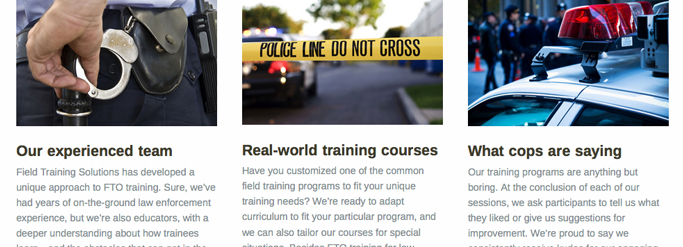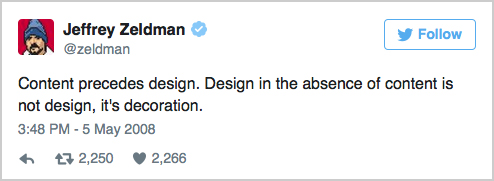When planning a new website, plan a “content first” approach

When I sit down and discuss a new website project with a client, they usually haven’t thought much about the actual text they will use to tell their website story (otherwise known as “site content”). And commonly, clients assume this text will be easy to pull together and will virtually “write itself.” Yes, the text that will actually appear on your site’s pages might be mostly in your head at this point, but you’ll have it ready when I need it…no problem!
In reality, your website content will be a big challenge to pull together.
You’ll need home page text, professionally written bios, product descriptions, services offered, calls to action, blog posts or feature articles, compelling messages, etc.—and you’ll need it written well.
Your website is your online branch office, your 24/7 service center, and it needs to be the very best salesperson you’ve ever had.
Have you spent time yet at your computer sketching out your site outline (page names) in a Word document? Have you drafted some sample page text? If not, and you’re ready to start on your new website project, you need to start now.
One of the things that stalls (or even derails) a new website project most easily is when the client doesn’t make content a priority.
Before starting your website design, I’ll need your content.
Even if I sketch out or design the home page based on our discussions, or know the page names that will be used in your main navigation area, or have images from you to use on the site, your new website still needs actual page text.
 Words inspire design! And when content is delivered first, a web project is more likely to launch on schedule. (The most common delay I experience for getting a new website live is lack of page content provided by clients.) We may completely map out your site and even start the design, but the project will go nowhere without descriptive text written for each page.
Words inspire design! And when content is delivered first, a web project is more likely to launch on schedule. (The most common delay I experience for getting a new website live is lack of page content provided by clients.) We may completely map out your site and even start the design, but the project will go nowhere without descriptive text written for each page.
Start by outlining the pages you’ll want on your site.
At the very least you’ll probably need the following pages:
- Home page—the entry point to your website where it’s essential to grab your visitor and inspire them to stay on your site by clicking further. Help them learn more about you and what you offer and make sure viewers know they are in the right place. The Hibu blog has a great schematic that helps you understand what your web visitors should see when they land on your home page. Make sure you include these elements on your home page. Click over and read about home pages in detail on How to develop an effective home page on your website.
- About page—where you share your uniqueness with the world. What makes you different? Why are your services the best? What inspired you to create your widget? The content on this page should really be more about engaging the potential customer than about you. Confused? Read 3 Core Reasons Why the “About Us” Page Matters on the Psychotactics.com blog.
- Services page—lists what you do, who you work with, and how a visitor can engage with your services. Rather than including a laundry list of everything you could do, focus on your specialty, your niche. What services do customers most commonly come to you to solve…what problems do you best solve…and what do you most love to do?
- Work/Portfolio page—examples of what you do in either a descriptive or visual format. It also might include rave reviews or testimonials to your great work.
- Contact page—A viewer is interested in you; how can they most easily get in touch? If you’re not around a phone much, then use your email address for business. And if you’re never at a computer, list your phone number instead. If you offer free consultations to potential customers, remind people here and describe this service. You could provide links to your professional Facebook page, your LinkedIn profile, or a Flickr gallery of product images and viewers can learn more about you. Be as thorough as possible on this page and make it easy for potential clients/customers to reach out and connect with you.
There might be dozens of pages you’ll potentially want on your site. Do you want to write and update a blog or news articles regularly? Do you want a gallery of photos?
Do your thinking early and sketch out what these pages might be for your designer. Then, get busy writing them.
You’ll want to write your text with a clear set of goals.
 Writing for websites calls for a special kind of writing: clear, concise headlines followed by targeted, shorter paragraphs. You’ll want the reader to be able to skim the page and find the answers they’re looking for without having to spend too much time on the page. In other words, if visitors immediately see they’ll find answers on your website, they’ll stay there. If you make them work too hard, they’ll leave and look somewhere else.
Writing for websites calls for a special kind of writing: clear, concise headlines followed by targeted, shorter paragraphs. You’ll want the reader to be able to skim the page and find the answers they’re looking for without having to spend too much time on the page. In other words, if visitors immediately see they’ll find answers on your website, they’ll stay there. If you make them work too hard, they’ll leave and look somewhere else.
Make sure you consider these points when writing your content:
- Who’s visiting this site?
- What does she want to know?
- What does he want to do?
- How do I want to make this user feel?
- How would I carry on a face-to-face conversation with him?
And if this is all too overwhelming and you aren’t able to generate website content yourself, I can suggest a great writer for the job.
If writing every word on your new website is a daunting task—one that might even prevent you from developing a site altogether—consider hiring writing and/or editing help. Good website writing is a great investment. When done you’ll have great headlines, a useful tagline, a killer professional bio, and effective descriptions of your products and services that can sell. It’ll be easy to transfer web text to a new brochure, your business’ Facebook posts, LinkedIn descriptions, and all other professional promotional venues. Writer Gail Trowbridge shares an office with me and is available to transform your rough or specific ideas into effective, targeted web text.
We usually work on websites together, integrating the writing and the design, and vice versa, to create a site that tells your story.
Your website is only as good as your written content. And the world doesn’t need any more slick and shiny-looking websites that fail to deliver on good content.
